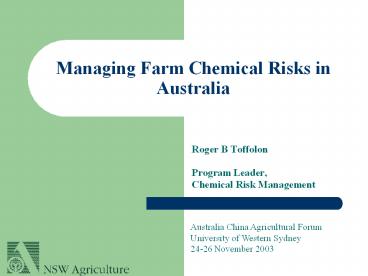Managing Farm Chemical Risks in Australia - PowerPoint PPT Presentation
Title:
Managing Farm Chemical Risks in Australia
Description:
... registered by the Australian Pesticides and Veterinary Medicines ... different food standards and maximum residue limits (MRL) apply in different countries; ... – PowerPoint PPT presentation
Number of Views:133
Avg rating:3.0/5.0
Title: Managing Farm Chemical Risks in Australia
1
Managing Farm Chemical Risks in Australia
- Roger B Toffolon
- Program Leader,
- Chemical Risk Management
Australia China Agricultural Forum University of
Western Sydney 24-26 November 2003
2
What are agricultural chemicals?
- agricultural chemicals includes
- insecticides
- fungicides
- herbicides
- chemicals used to control vertebrate pests
- attractants, repellents
- additives
3
What are veterinary chemicals?
- Includes chemicals that are used on animals and
livestock to - cure or prevent disease
- modify the physiology of an animal including its
productivity, development or reproductive
capacity - change its behaviour.
4
Multiple tiers of risk management
National Control
- Risk assessment of new chemicals and uses
- Control the supply of chemicals
- National policies for chemical management
- Maintain access to markets and facilitate trade
- Control how chemicals are used
- Enforce controls that protect the environment and
the health of consumers, the community and farm
workers
National and State
State Control
5
Regulating the supply of chemicals
- agricultural and veterinary chemicals can only be
supplied if they are registered - chemicals are registered by the Australian
Pesticides and Veterinary Medicines Authority
(APVMA) - the APVMA carries out a risk assessment of data
supplied by the manufacturer to determine the
safety of the chemical against five criteria - before chemicals are registered the APVMA must be
satisfied a chemical meets five criteria
6
The APVMA must be satisfied that
7
What are the international trade issues?
- APVMA must be satisfied that the international
trade issues arising from the use of the chemical
on produce are manageable - different food standards and maximum residue
limits (MRL) apply in different countries - different MRLs reflect different agricultural
practices - need to meet the standards of the importing
country - producers must consider MRLs when making chemical
selections.
8
What about the off-label use of agricultural
chemicals?
- off label uses can involve significant risks
- any off label uses must be assessed and approved
- off-label uses are assessed against the same
criteria as registered on-label use patterns - residue data required for new crops to set MRL
- off label approval can be issued for
- minor uses including minor crops
- emergency uses, or
- for research purposes
9
Regulating the use of agricultural chemicals
Pesticides Act 1999
- the user must follow the directions on the label
- agricultural chemicals must not be used in a
manner that causes - damage to property
- harm to non target plants or animals
- injury to another person
- harm to wildlife
- spray drift is the most common cause of
contamination - all chemical users must be trained
- producers must keep records of all chemicals used
10
- New requirements for making records of all
agricultural chemical applications - Need to ensure that all growers are aware of new
regulatory requirements including growers of
non-English speaking backgrounds
11
Regulating the use of veterinary chemicalsStock
Medicines Act
- only registered products can be used on food
producing animals - producers must follow the directions on the label
- but veterinarians can prescribe off-label use for
food producing animals - veterinarians must provide the user with clear
instructions for any off-label use
12
Protecting workers from harm
- most pesticides are hazardous substances
- employers must provide a safe workplace
- carry out a risk assessment to identify problems
- chemicals must be properly stored and records
kept - supply personal protective equipment
- provide material safety data sheets and other
information - training of employees
- workers must follow safe practices
13
Protecting consumers and food safety
- standards set for contaminants and chemicals in
food - food that does not meet standards must not be
supplied - chemical residues not generally a food safety
issue but can affect public confidence in the
quality and wholesomeness of food - microbiological contamination a bigger food
safety issue
14
Reducing risks without Regulation
- supply chain quality assurance schemes are
becoming increasingly important in delivering
quality products - training in risk management for chemical users
- good advice from NSW Agriculture on
- chemical selections
- adoption of best practices for chemical
application - reduce dependence on chemical controls and
adoption of integrated pest management
15
Good advisory publications and access to
information ensures that growers have the tools
to manage risk in the most efficient way































